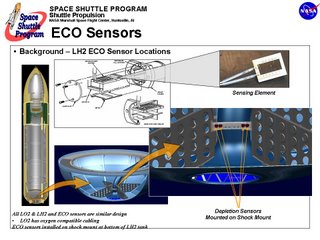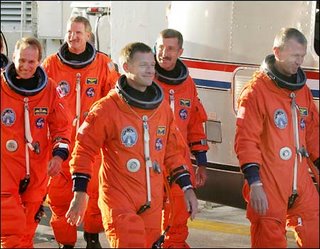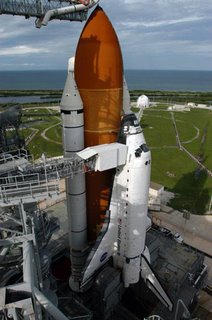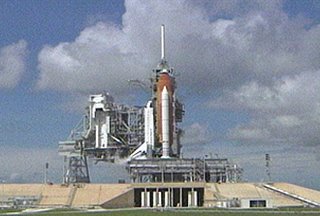SPACE SHUTTLE ATLANTIS WILL TRY ONE MORE TIME~9-9-2006~SATURDAY 11:15 AM~LIFTOFF ! YES !

Wow, what a beautiful site. Liftoff was beautiful ! The go with throttle up call was made and the solid rocket boosters have let go. All still looks good. The big "orange tank" is gone now too !! And she is on her way !! THAT'S A GOOD THING !! HAVE A GOOD TRIP ! Looks like it was a picture perfect launch and 5th try was the charm !! The Nasa Luunch blog is below.
Update its a go......!! whoo ho0 !!
update: Looking good so far..the space shuttle is in the last hold of 9:00 minutes. at the end of the page I have pasted the Nasa blog started this morning at 5:00 am.
NOTE: IF SPACE SHUTTLE ATLANTIC TAKE OFF SATURDAY, I WILL POST AN UPDATE IN ANOTHER POST.

Atlantis Set for Saturday Launch
Sept. 8, 2:00 p.m. EDTAt a Mission Management briefing, Shuttle Program Manager Wayne Hale discussed the ECO sensor problem that scrubbed today's launch saying that the engineers needed more time to study the data.
"We're going to review the data overnight," Hale explained. "If everything is performing as we expect and we just have one sensor continuing to be a bad actor, we'll launch tomorrow."
U.S. Air Force First Lt. Kaleb Nordgren of the 45th Weather Squadron at Cape Canaveral Air Force Station reported only a 20 percent chance of weather presenting a problem at the new launch time of 11:15 a.m. on Saturday.
The technical issue that caused the scrub arose earlier in the countdown when launch controllers detected a problem with one of the four engine cut-off (ECO) sensor systems inside the liquid hydrogen section of the space shuttle's orange external tank. The sensor system is one of several that protect the shuttle's main engines by triggering their shut down if fuel runs unexpectedly low.

THIS IS WHAT CAUSED THE DELAY ON FRIDAY.

THEY WERE READY TO GO. BUT..NO GO.

CREW THIS TIME INCLUDES A CANADIAN ON FAR RIGHT TOP.

AND THE SPACE SHUTTLE ATLANTIS SITS WAITING.

HOPE THE WEATHER WILL BE OKAY TODAY.

AND THE SHUTTLE AWAITS. 5TH TRY A CHARM MAYBE ?

A GREAT LINK BELOW TO NASA THAT WILL UPDATE YOU ON THE PROGRESS OF TODAYS LAUNCH.
http://www.nasa.gov/mission_pages/shuttle/main/index.html

NASA's Launch Blog - Mission STS-115
NASA's launch blog was activated at 5:00 a.m. EDT NASA's launch blog was deactivated at 11:30 a.m. EDT
11:23 a.m. - Main Engine Cut-Off and jettison of the external tank! Atlantis has reached orbit. Commander Brent Jett confirms a good separation. As the ET falls away it will be photographed.
11:22 a.m. - 7 minutes and 20 seconds into the flight.
11:21 a.m. - A little less than two and a half minutes of powered flight remaining. Atlantis has been told to "press to MECO" which means Atlantis could reach a safe orbit on two engines but all three are working fine.
11:20 a.m. - Atlantis is 65 statute miles downrange from the Kennedy Space Center.
11:16 a.m. - Mission-elapsed time two minutes, five seconds and Atlantis' twin solid rocket boosters have separated successfully.Atlantis has rolled back to a heads-up position now as it soars toward orbit.
11:14:55 a.m. - LIFTOFF!!! 3...2...1...and liftoff of Space Shuttle Atlantis...opening a new chapter in the completion of the International Space Station...for the future of collaboration of nations in space.
11:13 a.m. - T- 2 minutes The Shuttle Atlantis crew has been advised to close and lock the visors on their launch-and-entry helmets. T-16 seconds The launch pad's Water Sound Suppression System begins flooding the Mobile Launcher Platform with 300,000 gallons of water. The system protects the shuttle and its payloads from any damage cause by energy generated during launch.T- 10 seconds Flares ignite under Atlantis' three main engines and burn away any residual hydrogen that may have collected near the main engine nozzles.Half a minute into its climb, Atlantis' main engines will throttle down to about 72 percent. The engines will throttle back up to 104 percent about a minute into flight, just before the vehicles passes through maximum aerodynamic pressure known as Max Q.
11:10 a.m. - APU pre-start is complete and the units are ready for activation. The orbiter's "black boxes" to record flight data are now in the recording mode and will continue with data collection of the shuttle systems performance during the flight.
11:08 a.m. - Pilot Chris Ferguson has been given the "go" for APU start. He is flipping the three switches inside Atlantis' cockpit to start each of the three Auxilary Power Units.
11:07 a.m. - The Orbiter Access Arm (OAA) is being retracted from Space Shuttle Atlantis. In an emergency, it could be returned to its extended position in just 28 seconds if necessary. The White Room, which only a few hours ago provided access to Atlantis' crew module, is at the tip of the OAA.
11:05 a.m. - We are at T-9 minutes and counting.
11:00 a.m. - Launch Director Mike Leinbach is performing his poll for "go/no-go" for launch. The team is go! He wished "Godspeed" to the crew.
10:56 a.m. - The Shuttle Training Aircraft is checking the landing facility again for possible weather ceiling constraints at the return to launch site. The STA reports that the weather seems to be improving and is less than our constraints.
10:45 a.m. - The roll and pitch program will begin 10 seconds after Atlantis lifts off. The space shuttle will go through the region of maximum dynamic pressure at 49 seconds into the flight, and the solid rocket booster separation will occur at 2:05 minutes after launch. The orbital maneuvering system engines will begin firing at T+2:15 for just under three minutes to provide additional thrust. The shuttle will roll back to a heads-up position at 5 minutes 47 seconds in flight. The main engine cutoff will occur at 8 minutes 30 seconds after launch. The external tank will be jettisoned twenty seconds later. At that time, Atlantis will be in an elliptical orbit of 137 statute miles by 36 statute miles. Then 45 minutes after launch, there will be a 2-minute burn of the orbital maneuvering system to raise the perigee, creating a more circular orbit of 143 by 116 statute miles. Atlantis' orbit will then gradually be raised and further circularized to rendezvous with the International Space Station which is at an altitude of 218 miles.The primary overseas landing site is Moron, Spain, with Istres, France serving as back-up site. The Zaragoza, Spain site is under a threat of thunderstorms. The primary abort-once-around location is the Shuttle Landing Facility at the Kennedy Space Center, with the back-up site being White Sands Space Harbor in New Mexico. The primary end-of-mission site is the Shuttle Landing Facility at the Kennedy Space Center, and the alternate landing site is the Dryden Flight Research Facility at Edwards Air Force Base in California.
10:34 a.m. - This is the 27th flight of Space Shuttle Atlantis, which was delivered to the Kennedy Space Center in April, 1985. Atlantis' last launch was Oct. 7, 2002, carrying the S-1 Truss to the International Space Station. It was the fourth spaceship in the orbiter fleet, and first lifted off on Oct. 3, 1985, on the second Air Force dedicated mission. Atlantis is named after a two-masted sailing ship that was operated for the Woods Hole Oceanographic Institute between 1930 and 1966. Two of the most notable payloads it has flown are Galileo and Magellan.
10:20 a.m. We are at T-9 minutes and holding. The duration of this hold will be 41 minutes 39 seconds.Did You Know? The STS-115 crew members were announced in February 2002 and have been training together for more than four years.
10:16 a.m. - Water levels in the water spray boilers are about to be checked to make sure they are sufficient for launch. The helium system is being configured for launch. We will be entering our final hold in approximately three minutes.
10:09 a.m. - We are now at T-20 minutes and counting. The one remaining hold in the countdown will occur at T-9 minutes and last for about 40 minutes.
10:06 a.m. - Launch Pad 39B has now been cleared all non-essential personnel.
10:03 a.m. - NASA Test Director Jeff Spaulding is giving the T-20 minute briefing with final instructions to the launch team and STS-115 astronauts.
9:59 a.m. - We are now at the T-20 minute hold, which will last for ten minutes.
9:54 a.m. - The closeout crew has left Launch Pad 39B but will stand ready to return if there should be a launch scrub. Along with emergency crews, they remain available until after liftoff.
9:45 a.m. - The astronauts flying in the Shuttle Training Aircraft are heading out to check the status of a cloud to our west which could potentially become an issue with our launch weather criteria.Did You Know? The silver or gold wings on the astronauts' blue jumpsuits indicate that they are either in the Air Force or Navy. The silver wings denote the Air Force and gold indicates the Navy.
9:39 a.m. - The official targeted launch time for today is 11:14:55 a.m. EDT.
9:26 a.m. - Astronauts Kent Rominger and Steve Lindsey are taking off in the Shuttle Training Aircraft (STA) to do weather reconnaissance for launch. They will stay aloft until just before liftoff to assess the runway area at the Shuttle Landing Facility. They'll report to Dom Gorie, the firing room weather coordinator, and to the flight director in Houston.
9:25 a.m. - STS-115 marks the 200th time that we've tanked the space shuttle. These tankings have consumed 60 million gallons of liquid hydrogen delivered to Kennedy by more than 6,000 tanker trucks. Also consumed were 36 million gallons of liquid oxygen delivered by 8,600 tanker trucks.
9:17 a.m. - Terminal Countdown Range Safety "closed loop test" is underway. This test verifies the paths the destruct signal would travel and that the Shuttle's Range Safety Receiver responds correctly to the commands sent. This is also a health check of the range safety signal. Console operators in the Range Operations Control Center on Cape Canaveral Air Force Station, Fla. will also get verification that the orbiter has received the signal. Inhibits have been placed in the system to prevent inadvertent firing. The MILA Tracking System has been given direction to go from low power to high power in readiness for launch. Did You Know? Mission Specialists Heide Stefanyshyn-Piper, Dan Burbank and Steve MacLean are all slated to make their first spacewalks during this flight.
9:11 a.m. - Cabin leak checks are now in progress on Atlantis. There are no issues being worked and we are looking forward to an on-time launch at 11:15 a.m. this morning.9:06 a.m. - The hatch is now closed and locked for flight.
9:03 a.m. - Shuttle Weather Officer Kathy Winters is giving the latest weather briefing to Launch Director Mike Leinbach and conditions continue to be "green" for launch today.8:58 a.m. - The time remaining to the launch of Atlantis is now T-1 hour, 20 minutes and counting. The "go" was given by launch control to close and seal the orbiter's hatch. The closeout crew leader is making final preparations for closing. Once sealed, the leader will ensure that the hatch is properly pressurized for flight.
8:45 a.m. - The crew of Atlantis is performing air-to-ground communication checks with both Launch Control at Kennedy and Mission Control in Houston.
8:42 a.m. - The Ground Launch Sequencer (GLS) was activated at T-2 hours and is running. At T-9 minutes it will control the final phase of the launch countdown. The GLS is a master computer program which monitors approximately one thousand different measurements to ensure they stay within predetermined limits.Did You Know? Two STS-115 crew members are musicians in the astronaut rock band Max Q: Pilot Chris Ferguson plays the drums and Mission Specialist Dan Burbank plays guitar.
8:38 a.m. - At Atlantis' launch time, the International Space Station will be 50 degrees N latitude and 31 degrees W longitude, which brings the ISS near its northernmost orbit between Greenland and Iceland.
8:25 a.m. - The two solid rocket booster recovery ships, Freedom Star and Liberty Star, are stationed in the Atlantic Ocean about 140 miles northeast of the Kennedy Space Center (off the coast of Jacksonville, Fla.) in their mission station position. They were deployed on September 5 and arrived the next day. The booster recovery operation takes about six hours. The boosters are plugged, and compressed air is pumped into the interior, a procedure known as dewatering. This changes their position in the ocean from vertical and bobbing like buoys, to a horizontal position resembling logs in the water. This allows them to be towed back to Port Canaveral.After the ships retrieve the boosters, they are returned to the port to be prepared for shipment by train to Utah where they are readied for a future shuttle launch.
8:20 a.m. - Pilot Chris Ferguson is performing initial air-to-ground communications checks with the Launch and Mission Control centers, while the rest of the crew members are getting settled into the vehicle and making final preparations for flight. Each crew member will perform these communications checks with Launch Control at Kennedy and Mission Control in Houston.
8:14 a.m. - We are at T-2 hours 4 minutes and counting as the closeout crew completes the strap-in of the STS-115 crew. Did You Know? Pilot Chris Ferguson and Mission Specialist Heidemarie Stefanyshyn-Piper are both making their first journey into space on this mission. 8:05 a.m. - The last two crew members to enter Atlantis will be Mission Specialist Steve MacLean followed by Mission Specialist and Flight Engineer Dan Burbank.
7:49 a.m. - Mission Specialist Joe Tanner will be the second crew member to be seated in the orbiter, followed by Pilot Chris Ferguson, and then Mission Specialist Heidemarie Stefanyshyn-Piper.
7:48 a.m. - As shuttle commander, Brent Jett will be the first astronaut to board the shuttle. He will take the forward-left seat on the flight deck. + View Video (Real) + View Video (Windows) As each crew member is suited for launch, an orange glow stick is tucked into the shoulder pocket on the upper arm. Like the orange suits themselves, the glow sticks are intended to give the astronauts a means of identifying one another in the unlikely event of an emergency landing in darkness.Did You Know? Atlantis will take two days to arrive at the International Space Station after its launch from Kennedy Space Center, Florida.
7:42 a.m. - The STS-115 crew is now at Launch Pad 39B and will take the elevator in the fixed service structure tower to the 195-foot level to begin boarding the shuttle. The astronauts have specific seating designations for each launch. Often the seating assignments are changed for descent. There is room for up to four seats on the middeck and another four on the flight deck.
7:38 a.m. - The primary ascent guidance data is now being transferred to the backup flight system. The orbiter's on-board computers can be updated with the proper ascent profile, depending on the upper level wind situation at the time of launch. These profiles -- called I-loads -- tell the vehicle what the angle of attack is at various time and speeds during ascent.7:36 a.m. - Astronauts Kent Rominger and Steve Lindsey will be flying first a T-38, then the Shuttle Training Aircraft, to assess the weather during the launch countdown. The weather coordinator for this mission is Dom Gorie.
7:32 a.m. - After stopping at the Launch Control Center to drop off mission managers, the Astrovan continues the 4-mile journey to the launch pad. The closeout crew is at the pad awaiting their arrival. They will assist the crew with the rest of their equipment in the White Room and help them get seated inside the orbiter.
7:23 a.m. - The crew departed the crew quarters, taking the elevator to the main floor of the Operations and Checkout Building where they will walk outside to the "Astrovan" for the trip to Launch Pad 39B. + View Video (Real) + View Video (Windows)
7:19 a.m. - We are now at T-3 hours and counting. There are two remaining holds in the countdown, one at T-20 minutes and the last one at T-9 minutes.Did You Know? Astronaut Steve MacLean, who helped develop the Canadian-built robotic arms for both shuttle and station, will become the first Canadian to operate both systems during the STS-115 mission. 7:00 a.m. - With about 20 minutes remaining in the T-3 hour hold, our updated weather briefing indicates that we are still "green" with no violation of any weather constraints at this time. Weather will continue to be monitored throughout the countdown. The Ice Team has completed its inspection and is now leaving the launch pad.
6:54 a.m. - Assisting the crew to suit up in their pumpkin-orange launch and entry suits are the astronaut support personnel, also known as the "Cape Crusaders." The team is made up of five astronauts. The prime for this mission is Michael (Bueno) Good. Alan (Dex) Poindexter, Jose Hernandez, Kathryn (Kay) Hire and Barry (Butch) Wilmore are support. After final adjustments are completed, the flight crew will depart for the Launch Control Center where they will make a quick stop before continuing on to Pad 39B.6:52 a.m. - The following items took place during final prelaunch activities earlier this week:On Monday, the cryogenic reactants were loaded aboard Atlantis' onboard storage spheres located beneath the payload bay (used to generate power during the mission), the access platforms between the middeck and the flight deck were removed, and the orbiter's navigational aids were turned on and tested. Also, Atlantis' three main engines received a final checkout and were configured for launch including a test of the main engine controllers, which are the computer-like devices associated with the main engines. On Tuesday, the launch pad sound suppression system water tank was loaded with 300,000 gallons of water, the pad cameras were loaded with high-speed film and the tail service masts on the Mobile Launcher Platform were closed out for flight. On the space shuttle, the orbiter communications systems were turned on and tested, as well as the navigation systems and landing aids including the TACAN, microwave scanning beam landing system, the GPS and star tracker. The guidance system Inertial Measurement Units were also warmed up and checked. Also on Tuesday, late equipment stowage was completed, including placing the crew's Flight Data Files on board which include mission related items the astronauts will need as well as their personal effects.
6:50 a.m. - The astronauts have just completed their crew weather briefing and are headed to the suit up room.6:21 a.m. - We have 53 minutes remaining in this T-3 hour built-in hold. Due to the humid conditions today, any frost that forms will melt off the tank and give the impression of "falling snow."
6:06 a.m. - The Ice Team measures temperatures on various parts of the space shuttle and assesses debris concerns, on both the vehicle and on the pad, which might present a flight safety issue. The team members have several objectives, the most important of which is to assess the health of the external tank. They check the integrity of the thermal insulation and look for any ice or frost formations on the tank. The insulation allows the external tank to act as a large "Thermos bottle" for the super cold propellants. Because liquid oxygen is minus 297 degrees and the liquid hydrogen is minus 423 degrees, the tank actually shrinks by 6 inches once it's filled with the 526,000 gallons of cryogenics.Weighing in at approximately 57,000 pounds when empty and about 1.6 million pounds when loaded with propellants, the tank is the largest element of the space shuttle at 154 feet tall and 27.6 feet wide. Despite its size, the aluminum skin covering it is only an eight of an inch thick in most areas and still withstands more than 6.5 million pounds of thrust during launch.
5:58 a.m. - We are still in our planned T-3 hour hold. The Ice Team members are now at the Mobile Launcher Platform level of the launch pad as they finish up their inspection. The team uses a portable infrared scanner that gathers temperature measurements on the surface area of Atlantis. Preliminary reports indicate no issues at this time.
5:49 a.m. - We are now halfway through the T-3 hour hold. The Eastern Range Holdfire Test is beginning, checking the ability of Range Safety to stop the launch in the event that it would be unsafe to launch from a range standpoint. The navigation aids have all been activated. Did You Know? Atlantis was delivered to NASA's Kennedy Space Center in April 1985, and lifted off on its maiden voyage later that year. + Read More about Atlantis Preparing Atlantis for flight:+ View Video (Real) + View Video (Windows)
5:43 a.m. - The Ice Team continues to look for ice and debris on the orbiter and external tank at the 135-foot level and then will proceed to the Mobile Launcher Platform. Once finished, the team will report its findings to Launch Director Mike Leinbach in Firing Room 4.
5:39 a.m. - In the dining room of the Astronaut Crew Quarters, the STS-115 crew is enjoying the traditional preflight cake decorated with the mission insignia. After they finish, the crew will have a brief photo opportunity, suit up for flight and receive the latest weather briefing from the Ascent Flight Control Team at Mission Control in Houston.
5:23 a.m. - We are at T-3 hours and holding. The Ice Team is now heading down to the 195-foot level.
5:02 a.m. - The orbiter closeout crew has arrived at the White Room, connected to the end of the orbiter access arm catwalk that extends to Atlantis' crew module. They will make the final preparations for the astronauts' arrival at the pad about two hours from now. Shuttle Weather Officer Kathy Winters has given the latest weather briefing to Launch Director Mike Leinbach. Weather has improved for today's launch with only a 20 percent chance that weather could be an issue, primarily due the possibility of an isolated shower within 20 nautical miles at launch time.
5:00 a.m. - Good morning and welcome to NASA's Launch Blog. We are at T-3 hours and holding and Space Shuttle Atlantis is bathed in the glow of the xenon lights at Launch Pad 39B, awaiting liftoff later this morning. From Launch Control Center's Firing Room 4 at Kennedy Space Center in Florida, NASA Commentator George Diller begins live coverage of the countdown to launch of STS-115, Atlantis' mission to continue the assembly of the International Space Station. + View Video (Real) + View Video (Windows) The following events took place before the start of live coverage: The "Ice Team" arrived at Pad 39B and began its inspection from the 255-foot level and has progressed down to the 215-foot level. Team members will continue to inspect the entire shuttle, finishing their survey at the Mobile Launcher Platform (MLP) level. This inspection usually takes between two and three hours. The team is composed of seven NASA and contractor members, who carry binoculars and a telescope to get a better look at the hard-to-see areas. The team objective is to assess the integrity of the thermal insulation on the external tank. They also look for ice and frost formations on the tank, measure temperatures on various parts of the vehicle, as well as assess debris concerns on the shuttle and pad that could impact launch or flight safety.The Mission Management Team had their prefueling meeting at 12:30 a.m. and agreed to go ahead with tanking. Fueling operations began at 1:15 a.m. with the chilldown of the Main Propulsion System. The chilldown prepares the systems for the shock of the approximately 500,000 gallons of super-cold cryogenic liquid oxygen and liquid hydrogen fuels that will be pumped into the external tank. Launch weather remains at a 20 percent "no-go" for today with the primary concern being cumulus clouds within 10 nautical miles of Launch Pad 39B and showers within 20 nautical miles of the Shuttle Landing Facility. Temperature at launch time is expected to be 80 degrees with 85 percent relative humidity. At this time no other issues are being addressed by the launch team.The engine cut-off (ECO) sensors in the external tank, which scrubbed our attempt yesterday, have been tested during this time and all four are performing as expected. We entered the T-3 hour built-in hold at 4:20 a.m. and word was received that we are in stable liquid oxygen and hydrogen replenish to keep the tank topped off through the rest of the countdown. This hold will last for three hours in order to give the final inspection team more time to complete the checks of the shuttle's exterior after fueling. Activities underway during the past hour have been the inertial measurement preflight calibration, the alignment of the MILA tracking station antennas with the launch pad and the initial communications checks with the Air Force Eastern Range. The tanking of 528,000 gallons of the liquid oxygen and hydrogen was completed at
4:16 a.m. this morning just before we entered the T-3 hour hold. The Final Inspection and the Closeout Crew were given the all clear to head out through the roadblock to the pad at
4:23 a.m. The Final Inspection Team, also known as the "Ice Team," will begin the inspection of the shuttle for ice and debris once they arrive at the pad.










































0 Comments:
Post a Comment
<< Home